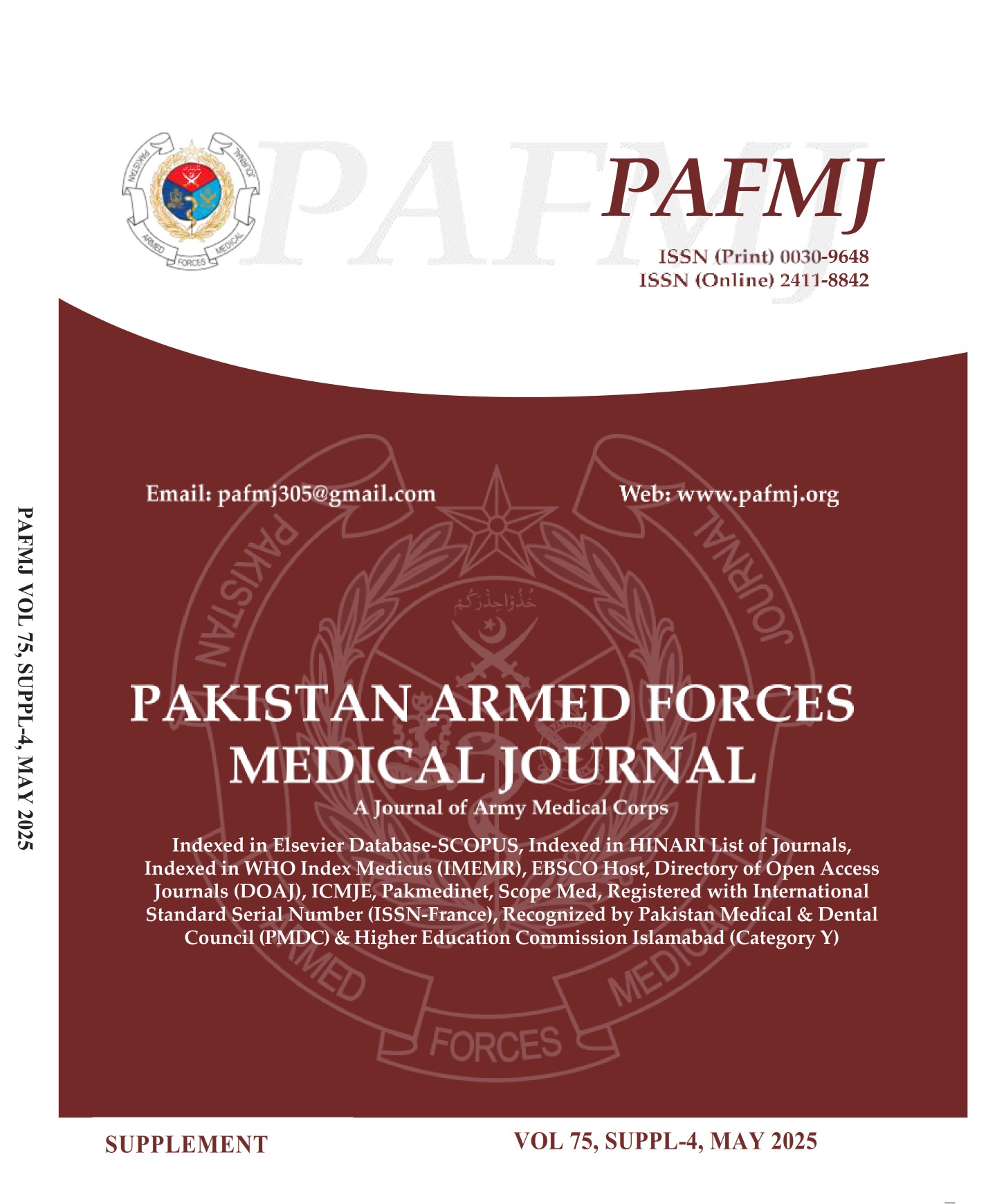The Efficacy of Intermittent Controlled Phlebotomy in Reverse Sural Artery Flap Surgery in Terms of Flap Congestion and Flap Survival
DOI:
https://doi.org/10.51253/pafmj.v75iSUPPL-4.9343Keywords:
Intermittent Controlled Phlebotomy, Reverse Sural Artery Flap.Abstract
Objectives: To determine the efficacy of intermittent controlled phlebotomy in reverse sural artery flap surgery in terms of flap congestion and flap survival.
Study Design: Quasi-experimental study.
Place and Duration of Study: Department of Plastic Surgery, Combined Military Hospital, Rawalpindi Pakistan, from Mar 2021 to Feb 2022.
Methodology: A total of 76 patients with lower limb skin defects requiring reconstruction were included in our study. Patients who suffered from neoplastic disease, those who had active infections or had received previous surgery for the defect were excluded. All patients underwent reverse sural artery flap repair. Patients in Group A received intermittent controlled phlebotomy by inserting 18 Gauge IV cannula in short saphenous vein during initial phase of flap harvest, while those in Group B did not. All patients were followed up for six-weeks post-surgery for the development of complications such as venous congestion.
Results: Our patients had a mean age of 46.32±19.06 years, of whom 43(56.6%) were women. Venous congestion occurred in 2(5.3%) cases with intermittent phlebotomy versus 10(26.3%) without it, (p=0.012). Flap necrosis also occurred at a lower rate: 2(5.2%) versus 8(21.1%) in those without it, (p=0.042). Remaining complications such as surgical site infections, paraesthesias, limitation of mobility and donor site complications had similar incidences across the two groups, (p>0.05).
Conclusion: Cases undergoing intermittent controlled phlebotomy have better outcomes in terms of the occurrence of complications versus those patients who do not receive the intervention.
Downloads
References
Hashmi DPM, Musaddiq A, Ali DM, Hashmi A, Zahid DM, Nawaz DZ. Long-Term Clinical and Functional Outcomes of Distally Based Sural Artery Flap: A Retrospective Case Series. JPRAS Open 2021; 30(2020): 61-73.
https://doi.org/10.1016/j.jpra.2021.01.013
AlMugaren FM, Pak CJ, Suh HP, Hong JP. Best Local Flaps for Lower Extremity Reconstruction. Plast Reconstr Surg Glob Open 2020; 8(4): e2774.
https://doi.org/10.1097/GOX.0000000000002774
Thakkar M, Bednarz B. Systematic Review of Free Tissue Transfer Used in Pediatric Lower Extremity Injuries. Eplasty 2021; 21(1): e2.
Saint-Cyr M, Wong C, Buchel EW, Colohan S, Pederson WC. Free tissue transfers and replantation. Plast Reconstr Surg 2012; 130(6): 858e-878e. https://doi.org/10.1097/PRS.0b013e31826da2b7
Johnson L, Liette MD, Green C, Rodriguez P, Masadeh S. The Reverse Sural Artery Flap: A Reliable and Versatile Flap for Wound Coverage of the Distal Lower Extremity and Hindfoot. Clin Podiatr Med Surg 2020; 37(4): 699-726.
https://doi.org/10.1016/j.cpm.2020.05.004
Finkemeier CG, Neiman R. Reverse Sural Artery Pedicle Flap. J Orthop Trauma 2016; 30 Suppl 2: S41-2.
https://doi.org/10.1097/BOT.0000000000000613
Masood T, Ahmed R, Obaidullah. Use of a special splint in reverse sural artery flap to reduce venous congestion and flap necrosis. J Ayub Med Coll Abbottabad 2016; 28(1): 63-66.
Athanaselis ED, Fyllos A, Zibis AH, Karachalios T, Hantes M, Dailiana Z, et al. A Single-Center Surgical Experience With the Reverse Sural Artery Flap as a Reliable Solution for Lower Leg Soft Tissue Defects, With Minimum Two-Year Follow-Up. Cureus 2021; 13(7): e16574.
https://doi.org/10.7759/cureus.16574
Khoshnevis J, Dashti T, Azargashb E, Kalantar Motamedi MR. How Much Can We do by Reverse Superficial Sural Artery Flap to Potentiate Its Effects: Introducing Spout Sural Flap as a New Modification. World J Plast Surg 2017; 6(3): 343-350.
Saaiq M, Zimri FUK. Reverse Flow Superficial Sural Artery Fasciocutaneous Flap: A Comparison of Outcome between Interpolated Flap Design versus Islanded Flap Design. World J Plast Surg 2019; 8(3): 316-323.
https://doi.org/10.29252/wjps.8.3.316
Rihan IS, Ali A, Hifny MA, Said SM. Super drainage Reverse-Flow Sural Flap for Distal Leg and Foot Reconstruction: A Method to Overcome Venous Congestion in Diabetic Patients. J Plast Reconstr Surg 2020; 44(1): 137-143.
https://doi.org/10.21608/ejprs.2020.88934
Ciofu RN, Zamfirescu DG, Popescu SA, Lascar I. Reverse sural flap for ankle and heel soft tissues reconstruction. J Med Life 2017; 10(1): 94-98.
Sugg KB, Schaub TA, Concannon MJ, Cederna PS, Brown DL. The Reverse Superficial Sural Artery Flap Revisited for Complex Lower Extremity and Foot Reconstruction. Plast Reconstr Surg Glob Open 2015; 3(9): e519.
https://doi.org/10.1097/GOX.0000000000000500
Asif M, Aslam M, Altaf S, Atif S, Majid A. Prevalence and Sociodemographic Factors of Overweight and Obesity among Pakistani Adults. J Obes Metab Syndr 2020; 29(1): 58-66.
https://doi.org/10.7570/jomes19039
Khan MIH, Azhar U, Zubair F, Khan ZA. Can we link foot ulcer with risk factors in diabetics? A study in a tertiary care hospital. Pak J Med Sci 2018; 34(6): 1375-1380.
https://doi.org/10.12669/pjms.346.16199
Baumeister SP, Spierer R, Erdmann D, Sweis R, Levin LS, Germann GK. A realistic complication analysis of 70 sural artery flaps in a multimorbid patient group. Plast Reconstr Surg 2003; 112(1): 129-140.
https://doi.org/10.1097/01.PRS.0000066167.68966.66
Parrett BM, Pribaz JJ, Matros E, Przylecki W, Sampson CE, Orgill DP. Risk analysis for the reverse sural fasciocutaneous flap in distal leg reconstruction. Plast Reconstr Surg 2009; 123(5): 1499-1504. https://doi.org/10.1097/PRS.0b013e3181a07723
Jafar NH, Mualla AI, Jassim AK. The Role of Phlebotomy in the Prevention of Pedicled Sural. Artery Flap Venous Congestion. Iraqi Postgrad Med J 2021; 20(4): 399-405.
Yusof NM, Fadzli AS, Azman WS, Azril MA. Acute vascular complications (flap necrosis and congestion) with one stage and two stage distally based sural flap for wound coverage around the ankle. Med J Malaysia 2016; 71(2): 47-52.
Dragu A, Bach AD, Kneser U, Horch RE. Two easy and simple modifications when using a distally based sural flap to reduce the risk of venous congestion. Plast Reconstr Surg 2008; 122(2): 683-684. https://doi.org/10.1097/PRS.0b013e31817d664f
Downloads
Published
Issue
Section
License
Copyright (c) 2025 Muhammad Ali Nasir, Shahid Hameed, Shumaila Javed, Muhammad Wajih Uddin Butt, Farman Mehmood, Khurshid Alam

This work is licensed under a Creative Commons Attribution-NonCommercial 4.0 International License.















